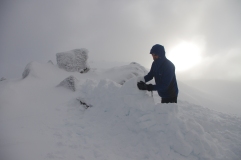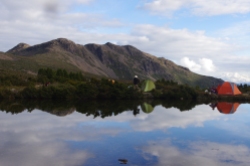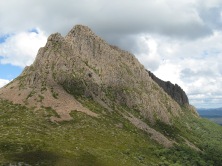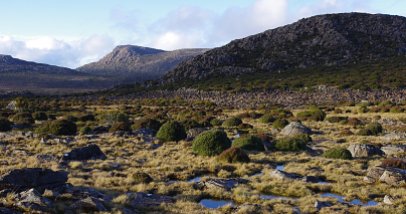Many people know the story of the Pine beetle which has been devastating huge areas of forest across North America because of climate change.
In brief, the mountain pine beetle’s ability to survive and multiply rapidly is highly sensitive to temperature and precipitation. Warmer average temperatures allow pine beetles to complete their life cycle in just one year instead of two. Rising minimum temperatures in the Colorado Rockies have allowed more beetles to survive the winter and from 2009 to 2010, mountain pine beetle activity increased more than 10-fold, infesting 200,000 acres (80,000 hectares) on the Front Range, and killing off millions of hectares of trees in North America.
There is a similar scenario emerging in Australia’s mountain forests, although it is much less known.
Snow gums are experiencing dieback in Kosciuszko National Park, largely because of the impacts of the native longicorn (or ‘longhorn’) beetle. These beetles prefer to lay their eggs on moisture-stressed trees and, in warmer weather, the longicorn beetle can hatch and grow up to 75% faster.
According to work published in the Resort Roundup winter 2019 edition (produced by the NSW government), ‘reduced snowfall, high summer temperatures such as January 2019 where temperatures at Thredbo top station were 4.4oC above average, and a reduction in autumn rainfall mean that snow gums are under much greater moisture stress than in the past.’ This means that larger beetle populations are causing more frequent dieback of some snow gum trees.
So far, impacts seem to be limited to areas in the Snowy Mountains among two distinct subspecies of snow gum – in the Guthega and Perisher areas and parts of Thredbo. The main species affected is Eucalyptus niphophila. Additionally, the population of Weeping snow gum Eucalyptus lacrimans in the Long Plain area appears to be significantly impacted by longicorn beetle. At this point it does not seem that the infestation is affecting the widespread E. pauciflora subsp. pauciflora.
Apart from the visual and ecological impacts of losing these important trees, increased dieback will lead to an increase in fire risk in alpine resorts and other areas within Kosciuszko National Park. With increasing climate change, it is expected that the longhorn beetle will continue to increase in numbers and therefore its associated impacts on snow gums will also become more extensive.
This is yet another compelling reason for us to be taking serious action to respond to climate change!
Here’s a summary of what we know. Thanks to Tim Scanlon of the NSW National Parks and Wildlife Service for this information.
Summary

Substantial dieback of alpine snow gums has expanded rapidly in recent years around alpine resorts and some other areas in Kosciuszko NP; particularly between 1600 and 1800m.
The vast majority of dieback appears to be linked to impacts from the native longicorn (or “longhorn”) beetle Phorocantha sp. One specimen extracted from infected trees has been identified as Phorocantha longipennis.
Reduced snowfall, high summer temperatures (e.g January 2019 temps for Thredbo AWS were 4.4oC above average), increase in the proportion of summer rainfall from high intensity rain events and the delayed commencement of winter rains (across southern Australia) all lead to increased moisture stress in alpine snow gums. In warmer weather the longhorn beetle can hatch faster and grow faster, completing its life cycle as much as 75% faster.
There are many unknowns about the species and its impacts / interactions.
Longicorn beetle and impacts on snow gums

Longicorn beetles prefer to lay their eggs on moisture-stressed trees although trees without moisture stress can still be affected. Moisture stress in alpine snow gums is greatest from January-April. Disturbance to the trees can also make them more susceptible. Healthy trees respond to boring by producing large quantities of gum that smother and effectively drown the larvae. High moisture levels in the bark can also effectively drown them.
Historically the beetles generally lived for a year or more within the tree in the larval stage although they can now complete their life cycle in as little as 6 months. They feed within the bark and cambium layer (and deeper) and their frass-filled tunnelling can ringbark branches and the trunks of mature trees.
Their impacts often commence in the upper branches of the tree. When ringbarked, the tree sends out epicormic shoots below the ringbark. Unfortunately, the larvae can then ringbark further down the stem or trunk, leading to further ringbarking and new growth until the whole trunk is dead. New growth from the base of the tree (lignotubers) appears to be weak and in many trees is not present as it has already exhausted its energy resources.
Some other negatives re: management of the species is it only lives in the adult stage for a relatively short period (i.e generally several weeks) and is active at night, so has few predators.
Impact locations and ramifications
Areas most impacted are around Guthega – a west facing slope highly exposed to westerly winds and the warmer drier afternoon sun. Impacts are also severe around Perisher and parts of Thredbo. Some trees near the altitudinal limit don’t appear to be as impacted – possibly through less moisture stress and colder conditions. Fire-affected trees are generally nowhere near as affected – possibly through the dead burnt trunks being harder, the regrowth from lignotubers being not as advanced or possibly even reduced moisture stress following the mass germination of groundcovers/shrubs in these areas post fire? Having said this, there are fire-affected trees that certainly are impacted. Will these trees be the next to be impacted as they mature?
Fortunately, at this stage the very old alpine snow gums growing above the Charlotte Pass village appear to be only slightly impacted and the trees seems to be regrowing well following some attack. Some of these trees do grow on west facing slopes however they are generally well protected in their tight bowl-shaped catchment. Areas around the Betts Camp/Spencers Creek Paralyser area also don’t appear to be as impacted.
The population of Weeping snow gum Eucalyptus lacrimans in the Long Plain area appears to be significantly impacted by longicorn beetle.
Dr Matthew Brookhouse from ANU has been investigating dieback in alpine snow gums Eucalyptus niphophila after undertaking dendrochronology studies of snow gums in the area with Keith McDougall and Gen Wright from the Office of Environment and Heritage (OEH). He recorded one site where there was evidence of polyphagous shot-hole borer Euwallacea sp. at Thredbo however all other damage appears to be from the longicorn beetle.
One of the major problems with the species is the return cycle where trees continue to be impacted; progressively weakening the tree with each attack.
With increasing climate change, it is expected that the longhorn beetle will continue to increase in numbers and its associated impacts on snow gums increase.
Increasing dieback leads to increased requests for removal of affected trees near lodges in alpine resorts. Prevalence of dieback will lead to an increase in fire risk in alpine resorts and other areas within Kosciuszko NP.
Researchers call for help
Researchers from The Australian National University (ANU) are asking the public to help investigate this phenomenon.
Dr Matthew Brookhouse says very little is known about ‘snow gum dieback’, despite it being widespread throughout the Australian Alps.
Because of the scale of the problem, and remote nature of the affected areas, observations from ‘citizen scientists’ are invaluable.
“We’re trying to determine the full extent of the phenomenon. We’re also keen to confirm the species of beetle responsible,” he said.
“But we’re in urgent need of help from the general public.
“Widespread dieback could have wide-ranging consequences.”
Trees affected by snow gum dieback are easy to spot.
The infestation typically starts in the upper branches and move towards the base of the tree.
The beetle larvae make deep, horizontal incisions in the tree as the bark dries out.
“These incision are typically two to four centimetres wide and are often stained dark red on recently killed trees,” Dr Brookhouse said.
“An outbreak of Phoracantha beetles in a living tree is generally a result of drought stress.”
A snow-gum dieback survey has been set up so the public can add their findings.
It was established with the help of the Atlas of Living Australia’s BioCollect program.
The survey can be accessed by downloading the BioCollect app.
People can also upload data online.
[Images courtesy of NSW National Parks and Wildlife Service].
On a side note, a similar dieback effect has been seen in eucalypts on the Monaro Tablelands in recent years. However this is the first time I have been aware of dieback occurring in snow gum populations.
























































Leave a comment